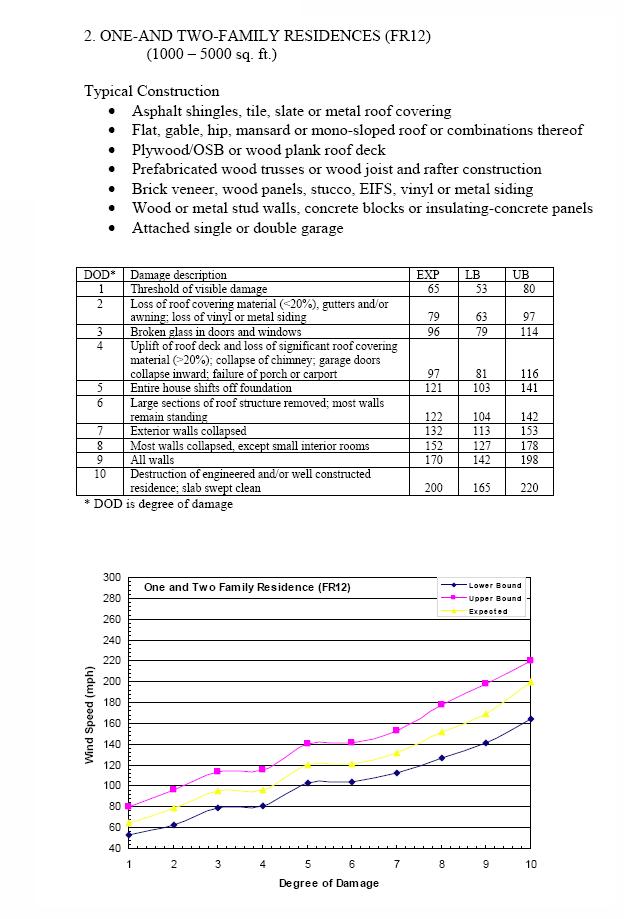scott r currens
EF3
For the first time I read through all 28 of the damage indicators on the new EF-scale. I was very surprised to see that a well-build, securely anchored, single-family-home has a maximum EF rating of EF4. Am I missing something? Isn’t this a significant change from the original Fujita Scale?
http://www.spc.noaa.gov/efscale/ef-scale.html

The following is a list of damage indicators and damage descriptions that indicate an EF-5 on the Enhanced Fujita scale.
LOWER LIMITS = EF-5
None
EXPECTED LIMITS = EF-5
11. Large Shopping Mall (LSM) – Complete destruction of all or a large section of the building. EXP 204 LB 176 UP 247
18. Mid-Rise Building: 5-20 Stories (MROB) – Permanent structural deformation. EXP 210 LB 181 UB 268
19. High-Rise Building: Greater than 20 Stories (HROB) – Significant structural deformation. EXP 228 LB 190 UB 290
20. Institutional Building (IB) – Significant damage to building envelope. EXP 210 LB 178 UB 268
UPPER LIMITS = EF-5
5. Apartments, Condominiums and Townhouses (ACT) (Three stories or less) – Almost total destruction of top two stories. EXP 180 LB 155 UB 205
6. Motels (M) – Total destruction of entire building. EXP 190 LB 163 UB 217
7. Masonry Apartments or Motels (MAM) – Total destruction of a large section of building. EXP 180 LB 160 UB 205
9. Small Professional Building (SPB) (Single story, less than 5000 square ft) – Total destruction of entire building. EXP 157 LB 148 UB 200
12. Large Isolated Retail Building (LIRB) – Complete destruction of all or a large section of the building. EXP 110 LB 147 UB 201
15. Elementary School (ES) – Total destruction of a large section of building or entire building. EXP 176 LB 152 UB 203
16. Junior or Senior High School (JHSH) – Total destruction of a large section of building envelope. EXP 192 LB 163 UB 224
17. Low-Rise Building: 1-4 Stories (LRB) – Complete destruction of all or a large section of building. EXP 188 LB 161 UB 221
[/QUOTE]
Given the new set of damage indicators what tornadoes that were rated F5 in the past would be rated EF5 today?
What about the Bridge Creek/Moore F5 or the Jarrell F5? I believe that the only structures rated F5 were single family homes. If I am wrong please let me know.
http://www.spc.noaa.gov/efscale/ef-scale.html

The following is a list of damage indicators and damage descriptions that indicate an EF-5 on the Enhanced Fujita scale.
LOWER LIMITS = EF-5
None
EXPECTED LIMITS = EF-5
11. Large Shopping Mall (LSM) – Complete destruction of all or a large section of the building. EXP 204 LB 176 UP 247
18. Mid-Rise Building: 5-20 Stories (MROB) – Permanent structural deformation. EXP 210 LB 181 UB 268
19. High-Rise Building: Greater than 20 Stories (HROB) – Significant structural deformation. EXP 228 LB 190 UB 290
20. Institutional Building (IB) – Significant damage to building envelope. EXP 210 LB 178 UB 268
UPPER LIMITS = EF-5
5. Apartments, Condominiums and Townhouses (ACT) (Three stories or less) – Almost total destruction of top two stories. EXP 180 LB 155 UB 205
6. Motels (M) – Total destruction of entire building. EXP 190 LB 163 UB 217
7. Masonry Apartments or Motels (MAM) – Total destruction of a large section of building. EXP 180 LB 160 UB 205
9. Small Professional Building (SPB) (Single story, less than 5000 square ft) – Total destruction of entire building. EXP 157 LB 148 UB 200
12. Large Isolated Retail Building (LIRB) – Complete destruction of all or a large section of the building. EXP 110 LB 147 UB 201
15. Elementary School (ES) – Total destruction of a large section of building or entire building. EXP 176 LB 152 UB 203
16. Junior or Senior High School (JHSH) – Total destruction of a large section of building envelope. EXP 192 LB 163 UB 224
17. Low-Rise Building: 1-4 Stories (LRB) – Complete destruction of all or a large section of building. EXP 188 LB 161 UB 221
[/QUOTE]
Given the new set of damage indicators what tornadoes that were rated F5 in the past would be rated EF5 today?
What about the Bridge Creek/Moore F5 or the Jarrell F5? I believe that the only structures rated F5 were single family homes. If I am wrong please let me know.
